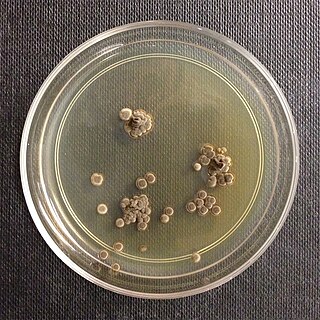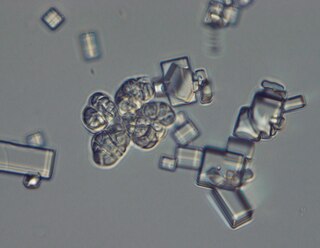A halophile is an extremophile that thrives in high salt concentrations. In chemical terms, halophile refers to a Lewis acidic species that has some ability to extract halides from other chemical species.
Halotolerance is the adaptation of living organisms to conditions of high salinity. Halotolerant species tend to live in areas such as hypersaline lakes, coastal dunes, saline deserts, salt marshes, and inland salt seas and springs. Halophiles are organisms that live in highly saline environments, and require the salinity to survive, while halotolerant organisms can grow under saline conditions, but do not require elevated concentrations of salt for growth. Halophytes are salt-tolerant higher plants. Halotolerant microorganisms are of considerable biotechnological interest.

Aureobasidium pullulans is a ubiquitous and generalistic black, yeast-like fungus that can be found in different environments. It is well known as a naturally occurring epiphyte or endophyte of a wide range of plant species without causing any symptoms of disease. A. pullulans has a high importance in biotechnology for the production of different enzymes, siderophores and pullulan. Furthermore, A. pullulans is used in biological control of plant diseases, especially storage diseases.

Hortaea werneckii is a species of yeast in the family Teratosphaeriaceae. It is a black yeast that is investigated for its remarkable halotolerance. While the addition of salt to the medium is not required for its cultivation, H. werneckii can grow in close to saturated NaCl solutions. To emphasize this unusually wide adaptability, and to distinguish H. werneckii from other halotolerant fungi, which have lower maximum salinity limits, some authors describe H. werneckii as "extremely halotolerant".
Black yeasts, sometimes also black fungi, dematiaceous fungi, microcolonial fungi or meristematic fungi is a diverse group of slow-growing microfungi which reproduce mostly asexually. Only few genera reproduce by budding cells, while in others hyphal or meristematic (isodiametric) reproduction is preponderant. Black yeasts share some distinctive characteristics, in particular a dark colouration (melanisation) of their cell wall. Morphological plasticity, incrustation of the cell wall with melanins and presence of other protective substances like carotenoids and mycosporines represent passive physiological adaptations which enable black fungi to be highly resistant against environmental stresses. The term "polyextremotolerance" has been introduced to describe this phenotype, an example of which is the species Aureobasidium pullulans. Presence of 1,8-dihydroxynaphthalene melanin in the cell wall confers to the microfungi their characteristic olivaceous to dark brown/black colour.

Wallemia sebi is a xerophilic fungus of the phylum Basidiomycota.

Wallemia ichthyophaga is one of the three species of fungi in the genus Wallemia, which in turn is the only genus of the class Wallemiomycetes. The phylogenetic origin of the lineage was placed to various parts of Basidiomycota, but according to the analysis of larger datasets it is a (495-million-years-old) sister group of Agaricomycotina. Although initially believed to be asexual, population genomics found evidence of recombination between strains and a mating type locus was identified in all sequenced genomes of the species.
Aspergillus restrictus is a species of fungus in the genus Aspergillus. It is from the Restricti section. The species was first described in 1931. It is xerophilic, frequently found in house dust. Studies have suggested that it is an allergen implicated in asthma. In 2016, the genome of A. restrictus was sequenced as a part of the Aspergillus whole-genome sequencing project - a project dedicated to performing whole-genome sequencing of all members of the genus Aspergillus. The genome assembly size was 23.26 Mbp.
Aspergillus conicus is a xerophilic species of fungus in the genus Aspergillus which can cause endophthalmitis in rare cases. It was first described in 1914. It is from the section Restricti. Aspergillus conicus has been reported as a human pathogen.
Aspergillus olivicola is a species of fungus in the genus Aspergillus. It is from the Nidulantes section. The species was first described in 2008. It has been isolated from fruit in Italy. A. olivicola has been shown to produce aflatoxin B1, emericellin, shamixanthone, siderin, sterigmatocystin, terrein, and varitriol.
Aspergillus filifer is a species of fungus in the genus Aspergillus. It is from the Nidulantes section. The species was first described in 2008. It has been reported to produce shamixanthones and varitriol.
Aspergillus halophilicus is a species of fungus in the genus Aspergillus. It is from the Restricti section. The species was first described in 1959. It has been isolated from dried corn in the United States and a textile in the Netherlands. It has been reported to produce chaetoviridin A, deoxybrevianamid E, pseurotin A, pseurotin D, rugulusovin, stachybotryamide, and tryprostatin B.
Aspergillus vitricola is a species of fungus in the genus Aspergillus. It is from the Robusti section. The species was first described in 1962 by Ohtsuki. It has been isolated from binocular lenses in Japan and house dust in Canada.
Aspergillus destruens is a species of fungus in the genus Aspergillus. It is from the Robusti section. The species was first described in 2017. It has been isolated from maize seed in the United States, an oil painting in Slovenia, air in a bakery in Slovenia, surface of cheese in the Netherlands, and indoor air in Hungary. It has been reported to produce asperglaucide.
Aspergillus hordei is a species of fungus in the genus Aspergillus. It is from the Robusti section. The species was first described in 2017. It has been isolated from barley in the United States. It has been reported to produce asperglaucide, aurantiamide, aurantiamide B, cristatine A, and echinulin.
Aspergillus pachycaulis is a species of fungus in the genus Aspergillus. It is from the Robusti section. The species was first described in 2017. It has been isolated from air in the United States. It has been reported to produce asperphenamate, indole alkaloid A, indole alkaloid B, phthalide, and mycophenolic acid.
Aspergillus reticulatus is a species of fungus in the genus Aspergillus. It is from the Robusti section. The species was first described in 2017. It has been isolated from a lung biopsy in the United States, air in Puerto Rico and elsewhere in the United States, dust in Belgium, oil paintings in Slovenia, and a leather shoe in the Czech Republic. It has been reported to produce asperglaucide, aurantiamide, indole alkaloid A, and clavatol D.
Aspergillus villosus is a species of fungus in the genus Aspergillus. It is from the Robusti section. The species was first described in 2017. It has been isolated in the UK and from a painting in France. It has been reported to produce asperphenamate, indole alkaloid A, and asperphenamate.
Wallemia mellicola is a xerophilic fungus of the phylum Basidiomycota, described in 2015 upon taxonomic revision of the species Wallemia sebi. A large amount of published research referring to W. sebi was likely actually performed on W. mellicola. An example of this is the sequencing of the W. mellicola genome, which was published under the name of W. sebi.
Fungal genomes are among the smallest genomes of eukaryotes. The sizes of fungal genomes range from less than 10 Mbp to hundreds of Mbp. The average genome size is approximately 37 Mbp in Ascomycota, 47 Mbp in Basidiomycota and 75 Mbp in Oomycota. The sizes and gene numbers of the smallest genomes of free-living fungi such as those of Wallemia ichthyophaga, Wallemia mellicola or Malassezia restricta are comparable to bacterial genomes. The genome of the extensively researched yeast Saccharomyces cerevisiae contains approximately 12 Mbp and was the first completely sequenced eukaryotic genome. Due to their compact size fungal genomes can be sequenced with less resources than most other eukaryotic genomes and are thus important models for research. Some fungi exist as stable haploid, diploid, or polyploid cells, others change ploidy in response to environmental conditions and aneuploidy is also observed in novel environments or during periods of stress.




